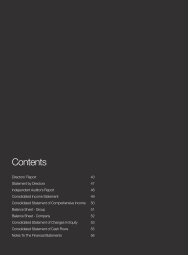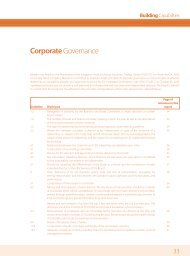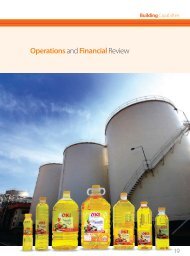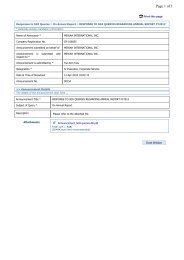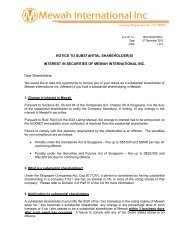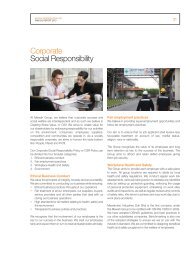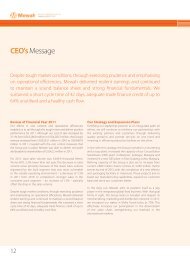Financial Statements - Mewah Group
Financial Statements - Mewah Group
Financial Statements - Mewah Group
Create successful ePaper yourself
Turn your PDF publications into a flip-book with our unique Google optimized e-Paper software.
Building Capabilities<br />
Notes to the <strong>Financial</strong> <strong>Statements</strong><br />
For the financial year ended 31 December 2011<br />
3. Critical accounting estimates, assumptions and judgements (continued)<br />
(b)<br />
Impairment of loans and receivables<br />
Management reviews its loans and receivables for objective evidence of impairment on a regular basis. Significant financial<br />
difficulties of the debtor, the probability that the debtor will enter bankruptcy, and default or significant delay in payments<br />
are considered objective evidence that a receivable is impaired. In determining this, management makes judgement<br />
as to whether there is observable data indicating that there has been a significant change in the payment ability of the<br />
debtor, or whether there have been significant changes with adverse effect in the technological, market, economic or<br />
legal environment in which the debtor operates in.<br />
Where there is objective evidence of impairment, management makes judgements as to whether an impairment loss<br />
should be recorded as an expense. In determining this, management uses estimates based on historical loss experience<br />
for assets with similar credit risk characteristics. The methodology and assumptions used for estimating both the amount<br />
and timing of future cash flows are reviewed regularly to reduce any differences between the estimated loss and actual<br />
loss experience.<br />
If the net present values of estimated cash flows increase or decrease by 5% from management’s estimates for all past due<br />
loans and receivables, the <strong>Group</strong>’s allowance for impairment will decrease or increase by US$1,062,000 or US$3,693,000<br />
and correspondingly to profit or loss.<br />
(c)<br />
Estimated impairment of non-financial assets<br />
Goodwill is tested for impairment annually and whenever there is an indication that the goodwill may be impaired.<br />
Intangible assets, property, plant and equipment and investments in subsidiaries and associates are tested for impairment<br />
whenever there is any objective evidence or indication that these assets may be impaired.<br />
The recoverable amounts of these assets and where applicable, CGU, have been determined based on value-in-use<br />
calculations. These calculations require the use of estimates such as expected cash flows resulting from operating margin<br />
and expenses, discounting rate and growth rate (Note 21).<br />
If the management’s estimated operating margin used in the value-in-use calculation for this CGU at 31 December 2011 is<br />
decreased by 5%, the carrying value of goodwill for this CGU would have been decreased, requiring additional impairment<br />
of US$410,000.<br />
If the management’s estimated pre-tax discount rate applied to the discounted cash flows at 31 December 2011 is<br />
increased by 5%, the carrying value of goodwill for this CGU would have been decreased, requiring additional impairment<br />
of US$78,000.<br />
If the management’s estimated growth rate applied to the discounted cash flows at 31 December 2011 is decreased by<br />
5%, the carrying value of goodwill for this CGU would have been decreased, requiring additional impairment of US$36,000.<br />
75



